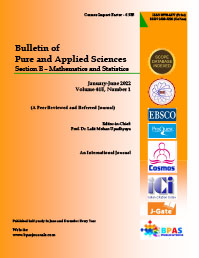TREND ANALYSIS OF EARTHQUAKES IN INDIAN SUBCONTINENT IN LAST TWO DECADES
DOI:
https://doi.org/10.48165/Keywords:
Trend Analysis, Earthquakes, Moving averages, Curve fittingAbstract
The Indian subcontinent has a history of overwhelming earthquakes. The main cause for the high frequency and intensity of the earthquakes is that the Indian plate is driving into Asia at a rate of approximately 50 mm/year in north–east direction. Geographical statistics of India shows that almost 54% of the land is susceptible to earthquakes. In this paper, we analyzed the trend of earthquakes that occurred during 2000-2019 in Indian continent by the method of moving averages and fitting the curve to the past data. Here, the past behavior of seismic events of different magnitudes and fatalities due to this natural hazard during last two decades has been discussed.
References
. Parvez, I. A. Vaccari, F. and Panza, G. F. (2003), A deterministic seismic hazard map of India and adjacent areas. Geophysical Journal international, 155, 489-508.
. Bendick, R.; Bilham, R.; Blume, F.; Kier, G.; Molnar, P.; Sheehan, A.; Wallace, K. (2002), Earthquake hazards and the collision between India and Asia, NOAA Science Review, 2002, Cooperative Institute for Research in Environmental Science.
. Sinvhal, Understanding Earthquake Disasters, p. 52, Tata McGraw- Hill, 2010, ISBN 978-0-07- 014456-9.
. Wadia, D.N.(1975), Geology of India, Tata McGraw Hill, New Delhi.
. Verma, R.K.(1991). Geodynamics of the Indian Peninsula and the Indian Plate Margin. Oxford and IBH Publication, New Delhi.
. Rajendran, C.P.(2000). Using geological data for earthquake studies: A perspective from peninsular India, Current Science, 79, 1251-1258.
. Arya, A.K., Pandey, V.K., Gupta, A. and Mishra, A.(2016).Seismological Trends in Indian Subcontinent, International Research Journal of Earth Sciences, 4(5),11-17.
